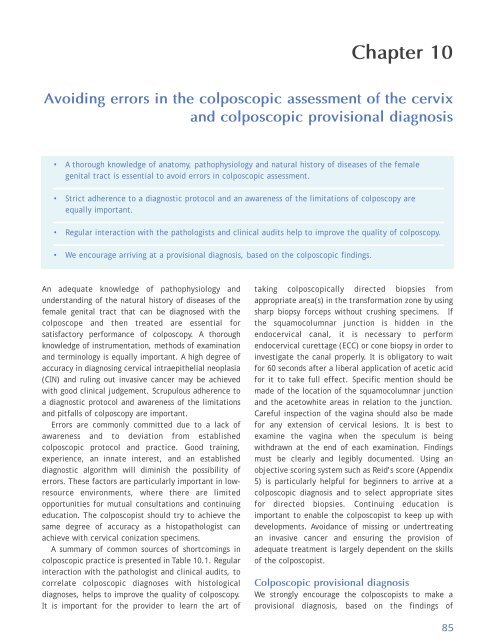Colposcopy and Treatment of Cervical Intraepithelial Neoplasia - RHO
Colposcopy and Treatment of Cervical Intraepithelial Neoplasia - RHO
Colposcopy and Treatment of Cervical Intraepithelial Neoplasia - RHO
You also want an ePaper? Increase the reach of your titles
YUMPU automatically turns print PDFs into web optimized ePapers that Google loves.
Chapter 10<br />
Avoiding errors in the colposcopic assessment <strong>of</strong> the cervix<br />
<strong>and</strong> colposcopic provisional diagnosis<br />
• A thorough knowledge <strong>of</strong> anatomy, pathophysiology <strong>and</strong> natural history <strong>of</strong> diseases <strong>of</strong> the female<br />
genital tract is essential to avoid errors in colposcopic assessment.<br />
• Strict adherence to a diagnostic protocol <strong>and</strong> an awareness <strong>of</strong> the limitations <strong>of</strong> colposcopy are<br />
equally important.<br />
• Regular interaction with the pathologists <strong>and</strong> clinical audits help to improve the quality <strong>of</strong> colposcopy.<br />
• We encourage arriving at a provisional diagnosis, based on the colposcopic findings.<br />
An adequate knowledge <strong>of</strong> pathophysiology <strong>and</strong><br />
underst<strong>and</strong>ing <strong>of</strong> the natural history <strong>of</strong> diseases <strong>of</strong> the<br />
female genital tract that can be diagnosed with the<br />
colposcope <strong>and</strong> then treated are essential for<br />
satisfactory performance <strong>of</strong> colposcopy. A thorough<br />
knowledge <strong>of</strong> instrumentation, methods <strong>of</strong> examination<br />
<strong>and</strong> terminology is equally important. A high degree <strong>of</strong><br />
accuracy in diagnosing cervical intraepithelial neoplasia<br />
(CIN) <strong>and</strong> ruling out invasive cancer may be achieved<br />
with good clinical judgement. Scrupulous adherence to<br />
a diagnostic protocol <strong>and</strong> awareness <strong>of</strong> the limitations<br />
<strong>and</strong> pitfalls <strong>of</strong> colposcopy are important.<br />
Errors are commonly committed due to a lack <strong>of</strong><br />
awareness <strong>and</strong> to deviation from established<br />
colposcopic protocol <strong>and</strong> practice. Good training,<br />
experience, an innate interest, <strong>and</strong> an established<br />
diagnostic algorithm will diminish the possibility <strong>of</strong><br />
errors. These factors are particularly important in lowresource<br />
environments, where there are limited<br />
opportunities for mutual consultations <strong>and</strong> continuing<br />
education. The colposcopist should try to achieve the<br />
same degree <strong>of</strong> accuracy as a histopathologist can<br />
achieve with cervical conization specimens.<br />
A summary <strong>of</strong> common sources <strong>of</strong> shortcomings in<br />
colposcopic practice is presented in Table 10.1. Regular<br />
interaction with the pathologist <strong>and</strong> clinical audits, to<br />
correlate colposcopic diagnoses with histological<br />
diagnoses, helps to improve the quality <strong>of</strong> colposcopy.<br />
It is important for the provider to learn the art <strong>of</strong><br />
taking colposcopically directed biopsies from<br />
appropriate area(s) in the transformation zone by using<br />
sharp biopsy forceps without crushing specimens. If<br />
the squamocolumnar junction is hidden in the<br />
endocervical canal, it is necessary to perform<br />
endocervical curettage (ECC) or cone biopsy in order to<br />
investigate the canal properly. It is obligatory to wait<br />
for 60 seconds after a liberal application <strong>of</strong> acetic acid<br />
for it to take full effect. Specific mention should be<br />
made <strong>of</strong> the location <strong>of</strong> the squamocolumnar junction<br />
<strong>and</strong> the acetowhite areas in relation to the junction.<br />
Careful inspection <strong>of</strong> the vagina should also be made<br />
for any extension <strong>of</strong> cervical lesions. It is best to<br />
examine the vagina when the speculum is being<br />
withdrawn at the end <strong>of</strong> each examination. Findings<br />
must be clearly <strong>and</strong> legibly documented. Using an<br />
objective scoring system such as Reid’s score (Appendix<br />
5) is particularly helpful for beginners to arrive at a<br />
colposcopic diagnosis <strong>and</strong> to select appropriate sites<br />
for directed biopsies. Continuing education is<br />
important to enable the colposcopist to keep up with<br />
developments. Avoidance <strong>of</strong> missing or undertreating<br />
an invasive cancer <strong>and</strong> ensuring the provision <strong>of</strong><br />
adequate treatment is largely dependent on the skills<br />
<strong>of</strong> the colposcopist.<br />
Colposcopic provisional diagnosis<br />
We strongly encourage the colposcopists to make a<br />
provisional diagnosis, based on the findings <strong>of</strong><br />
85
















